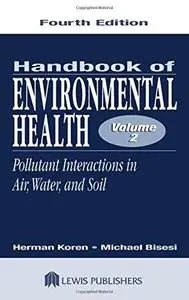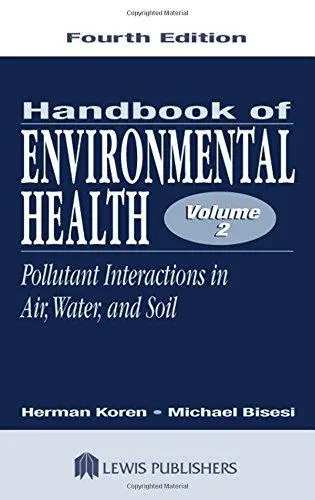Handbook of Environmental Health, Fourth Edition, Volume II: Pollutant Interactions in Air, Water, and Soil By Herman Koren, Michael S. Bisesi
2002 | 904 Pages | ISBN: 1566705479 | PDF | 30 MB
2002 | 904 Pages | ISBN: 1566705479 | PDF | 30 MB
The Handbook of Environmental Health-Pollutant Interactions in Air, Water, and Soil includes Nine Chapters on a variety of topics basically following a standard chapter outline where applicable with the exception of Chapters 8 and 9. The outline is as follows:1. Background and status2. Scientific, technological and general information3. Statement of the problem4. Potential for intervention5. Some specific resources6. Standards, practices, and techniques7. Modes of surveillance and evaluation8. Various controls9. Summary of the chapter10. Research needs for the futureChapter 1, Air Quality Management discusses various clean air acts, toxic air pollutants, the various types of pollutants, the composition of the atmosphere, global warming, ozone depletion, various atmospheric regions, air currents and movement, air temperature, inversions, urban and topographic effects, weather, physical properties of gases including various laws, psychometric properties of air, particulate matter, settling velocity of particles, particle retention in lungs, alteration and transportation of particulate matter, bubble concept. It also discusses various regulated air pollutants including nitrogen oxides, sulfur oxides, carbon monoxide, carbon dioxide, a range of hydrocarbons both aliphatic and aromatic, photochemical oxidants, organic gaseous discharges, simplified reactions in the atmosphere, ozone, methyl bromide, lead, asbestos, beryllium, cadmium, mercury, fluorides, odors. Air pollutants from incinerators, cement kilns, backyard burning, external combustion, internal combustion, attrition, evaporation, incineration, pulp and paper mills, iron and steel mills, petroleum refineries, metallurgical industries, chemical manufacturers, power plants, food and agricultural industries are also included. Air toxics and hazardous air pollutants are of considerable significance. Major source categories of air pollutants are discussed. There is a significant amount of material on disease and injury potential from air pollutants and a discussion of the respiratory system, the eye, systemic effect, digestive system. Economic effects are discussed including problems of visibility, acid deposition, global atmospheric changes. The latest standards, practices and techniques used for all of the air pollutants discussed as well as modes of surveillance and evaluation are in the text. Air pollution controls and state-of-the-art graphics are utilized to better understand how to control various air pollutants.Chapter 2, Solid and Hazardous Waste Management discusses residential waste, commercial waste, municipal waste, institutional and research laboratory waste, infectious and medical waste, industrial waste, food waste, yard waste, food processing waste, metal waste, paper, plastics, glass, wood, aluminum, chemical waste, rubber, radioactive waste, mining waste, agricultural waste, recreational waste, abandoned automobiles, packaging materials, refuse-derived fuels, heavy metals, toxic releases. It also discusses in detail pollution prevention and waste minimization, municipal solid waste reduction, Hazardous Waste and Resource Conservation and Recovery Act, Emissions Standards for Hazardous Air Pollutants, solid waste storage systems, on-site volume reduction systems, central volume reduction systems. Various collections systems, individual, community, industrial, agricultural are included. Sanitary landfills and the attendant problems are discussed in detail. Other concerns include types and properties of solid waste, hydrology and climatology, soils and geology, planning and design of landfills, site selection, types of soils, equipment, converting landfill gas and electricity. Incineration of various types are discussed including air emissions, general design of equipment, residue analysis and, incinerator process water, special waste handling. Composting and biological treatment includes physical and chemical processes, biological processes, different compost systems, innovative uses of compost. Pyrolysis includes pyrolysis oils, carbon black, reclamation and recycling. The disposal of solid waste includes the problems of land pollution, water pollution, air pollution, spread of disease through the waste and by means of insects and rodents. Chemical hazards in the human environment include endocrine disruptors, dioxins, other hazardous waste, injuries and occupational hazards. Types of hazardous waste include ignitable, corrosive, reactive, toxic waste. Hazardous waste transportation, waste discharge hazards, underground storage tanks are also discussed. Toxics release inventory, material handling technologies are significant. Redeveloping Brownfields are important. Standards, practices, and techniques are available for all forms of solid and hazardous waste disposal. The Superfund and the various acts related to it, are discussed. Study and evaluation techniques as well as controls and treatment techniques are an essential part of the material. Employee protection programs as well as other solid and hazardous waste programs and integrated techniques of disposal are part of the material.Chapter 3, Private and Public Water Supplies discusses the most recent laws and water quality. It also discusses the hydrologic cycle, human impact on the water cycle, hydrogeology, geographic information system, EnviroMapper, global positioning system. There is an extensive discussion of water treatment including chemical reactions, dosage and concentration terminology, environmental concerns, water distribution, wells, ponds or lakes, springs, rivers. Water treatment plants include state-of-the-art graphics of water intake, aeration, sedimentation, filtration, chlorination, storage including reservoirs where discussions of hypochlorination of water, ozone, aeration, chlorine, chlorine dioxide are described. Water supply problems include physical problems, chemical hazards, radiological hazards, groundwater and surface water relationships, groundwater contamination, public water system contamination by injection wells, polycyclic aromatic hydrocarbons, volatile organic compounds, gasoline. There is a discussion of risk assessment and risk management of water supplies. Biological factors include waterborne disease outbreaks, E. Coli 0157: H7 and Campylobacter outbreaks. Standards, practices, and procedures are established for safe drinking water. There’s a discussion and state-of-the-art graphics of dug or bored wells, driven wells, plumbing, drilled wells, well construction, well pumps, storage of well water, well testing, well disinfection, chlorination equipment, filters. Water treatment plant surveys, mapping programs for groundwater supplies, waterborne disease investigation are essential. Appropriate survey forms and US EPA studies and techniques are included. New technologies in water treatment are important.Chapter 4, Swimming Areas discusses water treatment, sources of water supply, pool hydraulic system, disinfection, swimming pool chemistry, chemistry of ozone in water, swimming pool calculations, therapeutic pools, bathing beaches and microbiological characteristics, recent outbreaks of disease, potential safety problems, current standards, practices and techniques, pool plans review, pool equipment, filtration systems, chemical feed, water testing, inspection techniques all accompanied by appropriate state-of-the-art graphics.Chapter 5, Plumbing discusses basic principles of plumbing related to environmental health, principles of hydraulics, cross connections, black flow, plumbing problems of public health significance, interceptors, separators, backwater valves, indirect and special waste, water supply and distribution systems, drainage systems, liquid medical waste, geothermal heat pump systems, tests and maintenance, means of preventing backflow, uniform plumbing code.Chapter 6, Private and Public Sewage Disposal and Soils discusses sources of sewage, appearance and composition of sewage, dissolved gases, biological composition of sewage, oxygen demand in sewage, chemical changes in sewage composition, decomposition of organic matter in sewage, biological sludges, sewage disposal concepts, sewage contaminants in groundwater, holding tank concept, sewage system infrastructure, primary treatment, secondary sewage treatment techniques including trickling filter systems, activated sludge process, rotating biological contactors, contact aeration process, intermittent sand filters, stabilization ponds, chlorination of sewage. Sludge digestion, treatment, and disposal techniques are discussed in depth. Advanced water treatment techniques, suspended solids removal, adsorption, oxidation, foam separation, distillation, electrodialysis, freezing, ion exchange, reverse osmosis, phosphate removal, nitrate removal are discussed. Package treatment plants are included. There is a substantial discussion of the topic of soils including soil profile, soil formation and composition, properties and qualities of soils, soil texture, permeability, soil structure, shrink-swell potential, classification and naming of soils, characteristic used to differentiate soils, effluents from septic tanks and soils, reduction of sewage effluent by soil, evapotranspiration and climate, soil-clogging effects of septic tank effluents, soil cleaning technologies, soil surveys. Equipment and systems are described in depth including septic tanks, aerobic tank systems, dosing tanks, soil absorption systems, and all forms of municipal treatment systems. State-of-the-art graphics is used throughout the chapter to highlight the information.Chapter 7, Water Pollution and Water Quality Controls discusses all of the federal laws related to water, water pollution, water quality and clean water. It also discusses wetlands, coastal waters, estuaries, the ocean, the effects of heat, acidity and alkalinity, conductivity, chemical oxygen demand-biological oxygen demand-dissolved oxygen relationships,...



